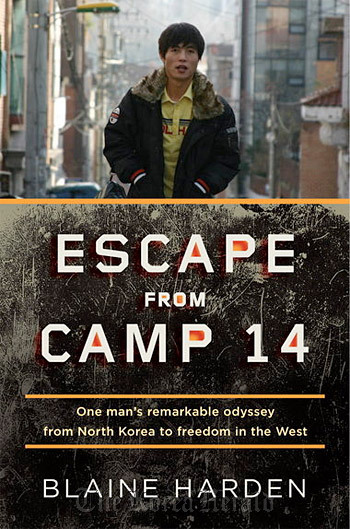
By Blaine Harden
(Viking)
A number of rallies and hunger strikes have been taking place in front of the Chinese Embassy in Seoul since February, after it was revealed that the Chinese authorities planned to repatriate about 30 North Korean refugees to the North -- where they face harsh punishment and possibly execution.
Amid the public criticism of Beijing in Seoul, former New York Times and the Washington Post writer Blaine Harden in March published “Escape from Camp 14,” a book which chronicles the remarkable journey of real-life North Korean defector Shin Dong-hyuk in the U.S.
Shin was born and raised in a North Korean concentration camp, which was located about 90 kilometers north of Pyongyang. He escaped the communist country in 2005 at the age of 24, and eventually landed in South Korea in 2006. No one born and raised in North Korean prison camps is known to have escaped except for Shin, according to the book.
During his years at the camp, Shin was forced to witness the public execution of prisoners twice a year. He had no concept of love and family, and only saw his mother “as a competitor for food.” When he was 14, he heard his mother and brother talking about a planned escape. He tipped off the authorities about his family members’ plan. His mother and brother were executed in public, and Shin was told to sit right in front in the crowd when they were killed.
“When guards dragged her to the gallows, Shin saw that his mother looked bloated. They forced her to stand on a wooden box, gagged her, tied her arms behind her back, and tightened a noose around her neck. They did not cover her swollen eyes,” Harden writes in the book.
“She scanned the crowd and found Shin. He refused to hold her gaze. When guards pulled away the box, she jerked about desperately. As he watched his mother struggle, Shin thought she deserved to die.”
According to the book, Shin thought both her mother and brother deserved to die, as they threatened his own survival in the camp. It was only after he escaped North Korea that Shin started to feel guilty and understand what he had done to his own family members.
At the age of 23, Shin made an attempt to escape the camp by crawling through an electrified fence with his friend, whose name was Park, when the guards were out of sight. Park was electrocuted by the fence. Shin used Park’s dead body as a shield to avoid the current and eventually found his way to Shanghai, China -- where he ran into a South Korean reporter who took him to the South Korean Consulate for asylum.
“For the first time in his life, Shin showered daily,” writes Harden. “He had new clothes, fresh underwear. Rested, scrubbed, and feeling increasingly safe, Shin waited for paperwork to be processed that would allow him to travel to South Korea.”
Harden also writes about Shin’s unhappy years after he made South Korea his second home; Shin moved to Southern California, the U.S., in 2009, after struggling with financial difficulties and an unfulfilling social life.
“I don’t want to be critical of this country,” Shin told Harden on the first day they met.
“But I would say out of the total population of South Korea, only 0.001 percent has any real interest in North Korea. Their ways of living do not allow them to think about things beyond their borders.”
While pointing out that Shin “exaggerated the South’s lack of concern about the North,” Harden writes Shin had a “valid point,” and criticizes Seoul for not paying enough attention to the human rights condition in North Korea.
“When South Korean president Lee Myung-bak was elected in 2007, just three percent of voters named North Korea as a primary concern,” he writes. “They told pollsters that their primary interest was in making higher salaries.”
According to the book, some 150,000 to 200,000 people work as slaves as North Korea’s prison camps. North Korea denies their existence, in spite of the “clearly visible” satellite photographs, the book says.
(dyc@heraldcorp.com)




![[Graphic News] Beer the most favored alcoholic drink by Koreans](http://res.heraldm.com/phpwas/restmb_idxmake.php?idx=644&simg=/content/image/2024/05/09/20240509050765_0.gif&u=)








![[Weekender] Pet food makers bet big on ‘recession-free’ pet food market](http://res.heraldm.com/phpwas/restmb_idxmake.php?idx=652&simg=/content/image/2024/05/10/20240510050754_0.jpg&u=20240511163252)




![[What to play] Musical tributes to family in the month of family](http://res.heraldm.com/phpwas/restmb_idxmake.php?idx=642&simg=/content/image/2024/05/09/20240509050795_0.jpg&u=)